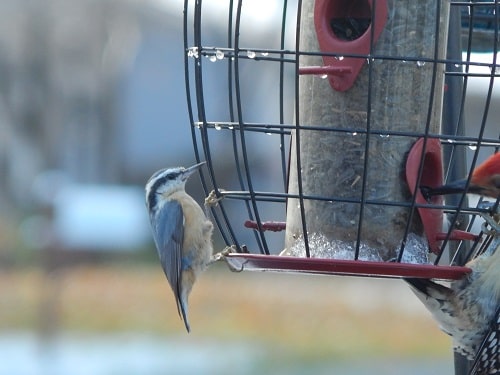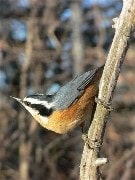Red-Breasted Nuthatch Mating, Nesting, and Feeding Habits
These are called "irruptive movements" which is defined as an unpredictable migration of a species outside its typical range. Red-breasted Nuthatches will do this often.
Description: Size - Field Marks

The Red-breasted Nuthatch measures about 4 1/2 to 5 1/2 inches in length. With a black cap, black eyeline, and white eyebrow.
A stocky, small bird, with a short tail. Blue-gray back with rusty underparts.
The female and young have duller head markings and lighter underparts.
Mating Habits
Considered monogamous, these birds carry out their courtship displays at the top of trees.
Males can be heard singing their courtship song in early morning, also from the top of trees.
Nesting Habits and Behaviors
Beginning in late April early May, the Red-breasted Nuthatch pair begins excavating a cavity nest in a dead, decaying tree.
Females typically choose the nesting site, though males may start excavating possible locations within their territory before pairing. Aspen and Fir trees are most often preferred.
Females perform the bulk of the excavating while the male brings her food.
The nest site can be anywhere from 5 to 100 feet above ground. Although 15 feet above ground is about average. Unlikely to use bird houses.
Inside the cavity, bark strips, grass and plant fibers are placed at the bottom for nesting materials.
| Red-breasted Nuthatch Nesting Season Timeline | |
|---|---|
| Eggs | 4 - 7 |
| Incubation | 12 - 13 days |
| Nestling Phase | 18- 21 days |
| Broods | 1 |
An interesting behavior of note about these birds, is their habit of placing droplets of resin, or pitch, from balsam fir, or pine trees to smear around the entrance hole of the nesting site.
This practice continues throughout the nesting phase, resulting in an area sometimes 2 inches or more smeared with the sticky substance.
The reason for doing this is really unknown. Speculation is to keep ants and small mammals from entering since they have to walk or crawl through the pitch.

The Nuthatches themselves are able to fly straight into the hole without being affected by the pitch.
The female lays 4 - 7 eggs that are white and finely spotted with brown. Incubation last about 12 - 13 days. Sources differ on whether the female or both male and female incubate.
The young leave the nest 18 - 21 days after hatching. Some young are independent within 2 weeks, others may stay with the adults through the winter.
Feeding Habits/What They Eat
The diet of Red-breasted Nuthatches consists of conifer seeds and insects.
At the bird feeder during winter, they join flocks of chickadees, titmice, and Downy Woodpeckers.
Watch them at the feeder as they take a single sunflower seed, fly away to a branch, and eat it before returning for another.
Make sure to have you suet feeder ready as both Red-breasted and White-breasted nuthatches love suet.







